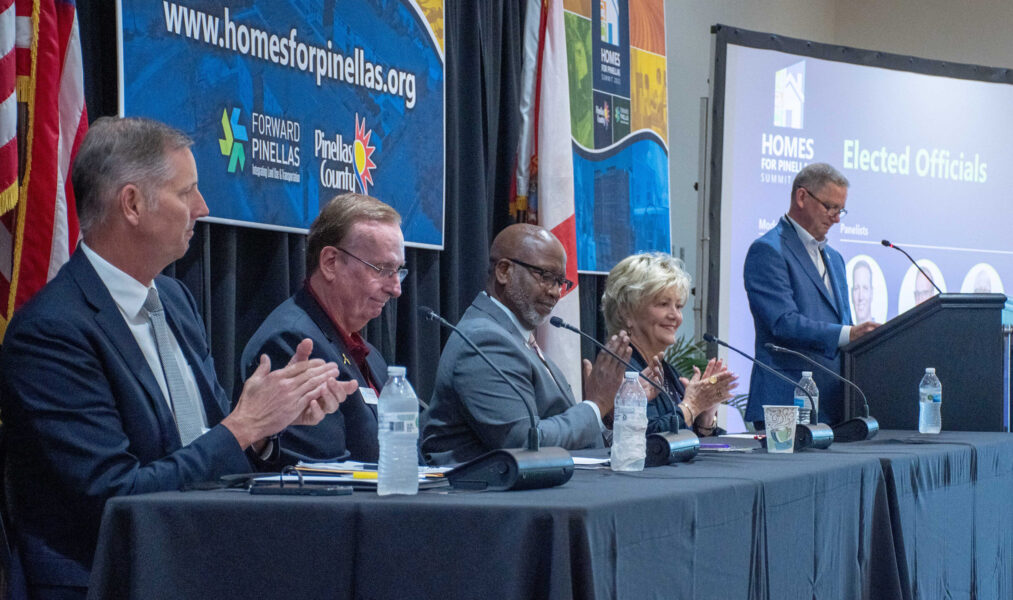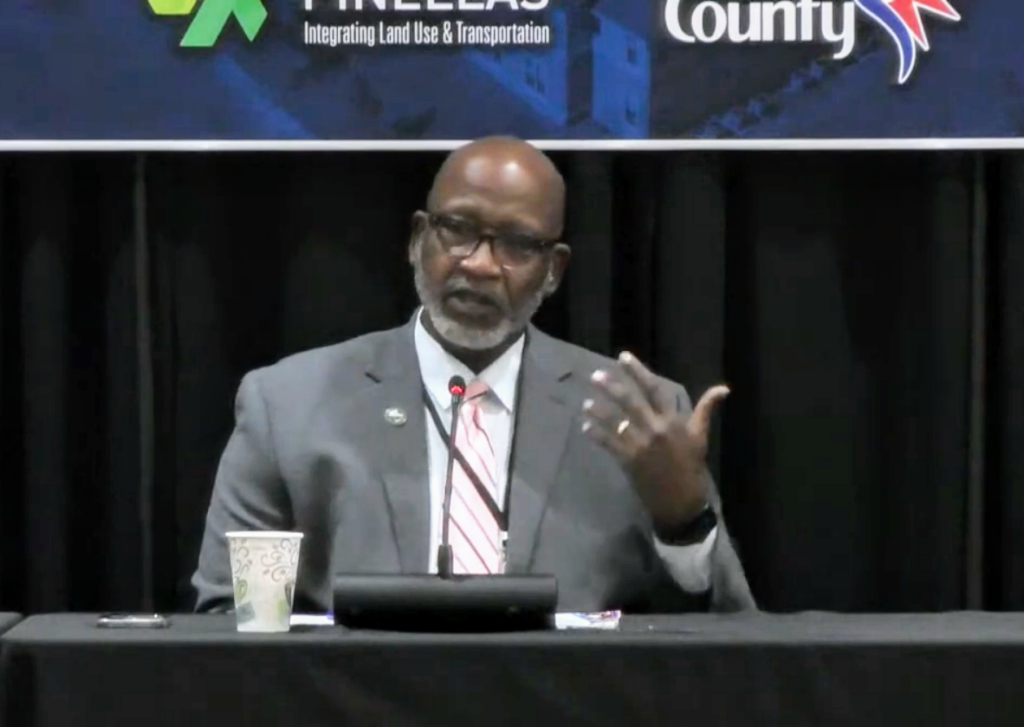Thrive
Elected officials come together for housing solutions

Local leaders are collectively addressing a problem showing no signs of abating, as one in three families struggle to afford housing in Pinellas County.
Elected officials, business owners and community stakeholders came together April 28 to publicly launch the new countywide Housing Action Plan. The Homes for Pinellas Summit featured a full day of presentations, with St. Petersburg Mayor Ken Welch participating on a panel with Clearwater Mayor Brian Aungst Sr., Largo Mayor Woody Brown and County Commission Chair Janet Long.
Whit Blanton, executive director of Forward Pinellas, moderated the discussion at the Central Park Performing Arts Center in Largo. Much of the conversation centered on increasing transportation options and density in a well-developed county with significant swaths of urban sprawl.
“No matter who you are, this is a humanity issue,” Long said. “If you found yourself deserted on a deserted island, what is the very first thing you would be looking for? Before you looked for food, you would look for shelter.”
Welch noted that he recently made business trips to London and Austin. A lack of workforce housing was a pervasive topic throughout both, and he said Austin’s leadership expressed their regret for not taking a more aggressive approach to the problem 10 years ago.
Welch said local leaders must prioritize the issue and increase efforts to inform the NIMBY (not in my backyard) crowd. He explained that affordable housing developments are clean, safe and well-maintained, unlike the “projects” of decades past.

Mayor Ken Welch suggested that the U.S. Highway 19, or 34th Street in St. Petersburg, corridor could serve as the next SunRunner route. Screengrab.
Brown said Largo officials are comprehensively and intentionally changing development regulations. That includes allowing and encouraging mixed-use density along commercial corridors.
“If we don’t do something, it’s only going to get worse,” he said. “The best time to do something was about 15 years ago, but this is probably the second best.”
Pinellas County, Forward Pinellas and the Cities of Clearwater, Gulfport, Largo Oldsmar, Pinellas Park, St. Petersburg and Treasure Island have committed to the Advantage Pinellas Housing Compact.
The subsequent Housing Action Plan includes updating codes; simplifying regulations; maximizing housing near transportation, jobs and other amenities; solidifying new funding sources; incentivizing permanent affordability; empowering struggling residents to protect and improve their homes; setting housing goals to fill the current gap; and transform surplus government land into homes through public-private partnerships.
“Pinellas County was developed in a way that doesn’t work in today’s world,” Brown said. “With some exceptions of some old, historic downtowns, where there’s connected pedestrian networks and higher density housing and taller buildings, most of Largo and most of Pinellas County is that suburban sprawl.”
Pinellas is Florida’s smallest yet most densely populated county, and Aungst said many people do not realize when they cross city limits. Like his fellow panelists, he believes that increases the need for partnerships and housing near transportation hubs.
Aungst was also part of the local delegation in London. While he said everyone they spoke with couldn’t afford to live in the city, they could utilize a “robust” transportation network.
He relayed that 11% of Clearwater residents lack personal transportation, while 54% have one vehicle.
“If you’re talking about a married household with children, one vehicle is more than a challenge,” he added. “So, trying to get businesses and trying to get housing near transportation centers is of the utmost importance.”
Blanton noted that U.S. Highway 19, or 34th Street in St. Pete, unites the county’s municipalities. Welch said he sees growth potential along the thoroughfare, particularly around the city’s southernmost portions.
The Skyway Lofts provided 65 affordable units in the area, and phase two of the development is underway. He expressed excitement for the Skyway Marina District’s evolution and suggested that the SunRunner – the region’s first bus rapid transit (BRT) service – could stimulate development.
“Is that our next corridor for BRT, which is breaking records beyond projections on the SunRunner?” Welch asked rhetorically. “So, for U.S. 19, I see several opportunities. Not just for housing, but for expanding our transportation options.”

County Commission Chair Janet Long would like to see the SunRunner extend to Pasco County and downtown Tampa.
Long called herself “a product of the world we live in today” after she and her young daughter moved to Pinellas from New York City in 1972. She had a 3-year-old daughter, no job, no place to live and no money to buy a car.
A cousin let her borrow a vehicle, and providing public transportation options became a passion. She relayed that her discussions with Pasco County officials on extending the SunRunner route north are ongoing.
Long would also like to see it connect to the proposed Brightline high-speed train terminus in downtown Tampa. She told attendees that there is “more to come” regarding those efforts.
However, she noted that land-use initiatives are among the “hardest problems” to address on the commission.
“This is about elected officials making tough decisions,” Long said. “Tough decisions mean you make some people happy, and you make a lot of people mad.”
Welch noted the community pushback St. Petersburg officials received when recently implementing zoning changes along major transit corridors. He said local leaders must have the courage to “speak truth” to people who might not understand the proposed changes and who it would benefit.
He recalled hearing residents state that “they don’t want those people in their neighborhood.”
“Well, who are those people?” Welch added. “These are the folks that when you go into the emergency room, they are taking care of you. Or they’re taking care of your kids after school.
“That triad of transportation, housing and jobs has to be complete for us to move forward.”








Mendee Ligon
May 2, 2023at6:29 pm
Immediate relief is needed.. coming together to talk about it is not fixing it! This issue is not new but has grown worse because of rapid development. Do Mayors actually have the power to address this?
The attractors for developers to income a small portion is a puny contribution
plomi
May 2, 2023at8:46 am
NIMBY is a derogatory term used primarily by leftists to justify ignoring the valid concerns of (primarily whíte people) who bought into a neighborhood for a reason and would prefer to keep as many positive qualities as possible.
The fact of the matter is that the whole country is having some form of the same housing issue. The market is being slow to respond to rising rates and the dissipation of excess cash. There’s nothing local politicians can do to fix this, and there’s a decent likelihood they’ll mess something else up. The best course of action here is to hold tight and let the market work itself out. We will find equilibrium again eventually.
Cy Ense
May 1, 2023at5:59 pm
Always laughable to see local politicians avoid the #1 issue that contributes to housing unaffordability: city + county property taxes.
Mike
May 1, 2023at4:56 pm
“Welch said local leaders must prioritize the issue and increase efforts to inform the NIMBY (not in my backyard) crowd. ” the amount of arrogance is jaw dropping. By “nimby crowd” you mean every resident of every neighborhood? Somehow welch knows better than the residents that have flesh in the game?? If only the city gave the same deference to residents that it does the crowd who lines up to spend other people’s money. It’s disgusting.
Rita Sewell
May 1, 2023at4:23 pm
Since hospitals and education are strong employers in the area should they also be stakeholders in the housing planning. I know the Tomlinson property is in the planning stages. All Children’s has that parcel behind Bayfront that would be very convenient for hospital workers in the lower wage positions as well as nursing students attending local colleges. Then there are church properties that might consider affordable or senior housing on their land. St Bedes Episcopal recently closed. What is the plan for that land? We must all look into our hearts and work together for the good of all.